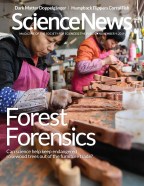Readers react to rechargeable batteries and more
- More than 2 years ago

Safety first
Three scientists won the 2019 Nobel Prize in chemistry for developing lithium-ion batteries, Maria Temming and Jonathan Lambert reported in “The development of the lithium-ion battery has won the chemistry Nobel Prize” (SN: 11/9/19, p. 12). Since the rechargeable batteries were first created in the 1970s, they have become safer and cheaper.
“I love my devices, but it’s not yet a brave new world for tech,” reader Doug Pruner wrote. Victims of lithium-ion battery explosions would probably emphasize that “safer” batteries are not necessarily “safe,” Pruner noted. “Marketing pressures, not tech, drive the push for more power and concurrent smaller size. Sometimes, Kaboom!” he wrote.
Temming agrees that lithium-ion batteries aren’t totally safe. The batteries can explode when heat from a short circuit ignites their highly flammable liquid electrolyte. Exploding smartphones, wireless headphones and hoverboards have made headlines.
Amanda Morris, a chemist at Virginia Tech in Blacksburg, told Temming that researchers are developing new materials to incorporate into lithium-ion batteries that don’t short-circuit or combust as easily. “Solid gel electrolytes are supposedly more robust than traditional liquid,” Temming says.
Meanwhile, some scientists are figuring out ways to add flame retardants to the liquid electrolyte in lithium-ion batteries. But mixing in flame retardants makes the batteries less efficient. To solve this problem, one group developed microscopic plastic-coated fibers that contain a flame retardant. If a battery overheats, the fibers’ plastic shells melt and release the flame retardant into the liquid (SN: 2/18/17, p. 19).
Correction
In “How 2019’s space missions explored distant worlds” (SN: 12/21/19 & 1/4/20, p. 32), the NASA InSight mission on Mars is described as having a rover. InSight actually has a stationary lander.